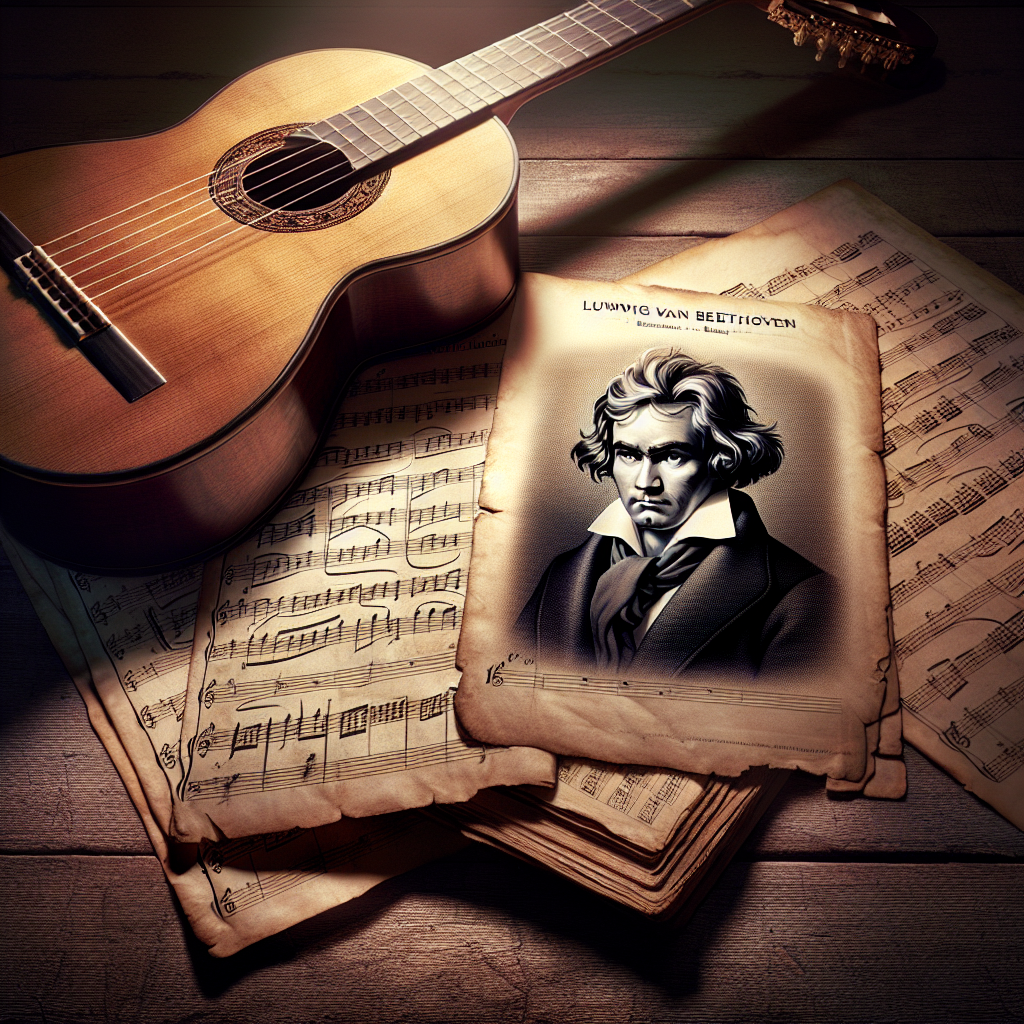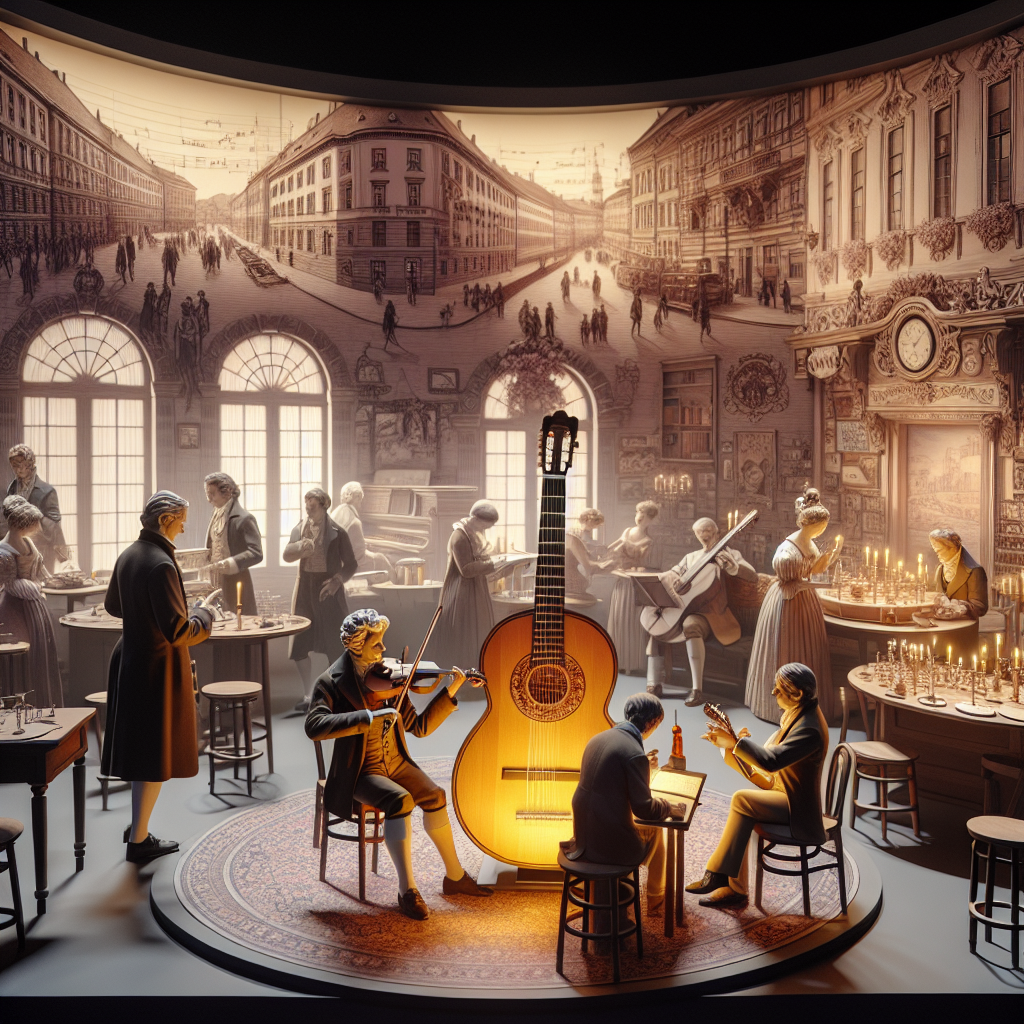
The Classical Guitar in Beethoven’s Vienna – Influence on His Works
Ludwig van Beethoven remains one of the most celebrated and influential composers in the history of Western classical music. His music, marked by a profound emotional range and innovative structure, continues to resonate with audiences worldwide. Born in Bonn, Germany, in 1770, Beethoven moved to Vienna in 1792, which at the time was the epicenter of the Western classical music world. This decision would shape his career and life profoundly. In Vienna, Beethoven was surrounded by numerous influential musicians and composers who contributed to his musical education and growth. Notably, the classical guitar, an instrument experiencing a surge in popularity during this period, played a unique role in the musical environment of Beethoven’s Vienna. This article delves into the life and history of Ludwig van Beethoven, with a special focus on the influence of the classical guitar and his contemporaries on his works.
The period during which Beethoven was active in Vienna was a time of significant musical evolution. The classical guitar, with its rich, mellifluous tones and versatility, had begun to capture the imagination of composers and audiences alike. Although Beethoven himself did not compose extensively for the classical guitar, the instrument’s growing prominence in the musical circles of Vienna influenced his compositions and performance style indirectly. At the heart of this influence was the vibrant exchange of musical ideas and the collaboration between various musicians and composers in the city.
The Rise of the Classical Guitar in Vienna
By the late 18th and early 19th centuries, the classical guitar had begun to emerge as a prominent instrument in Vienna. The city’s musical landscape was rich with innovative composers such as Mauro Giuliani and Fernando Sor, who were celebrated for their virtuosity and compositional prowess for the guitar. These musicians contributed significantly to the classical guitar repertoire, and their works were frequently performed and admired in Vienna’s salons and concert halls.
The classical guitar’s appeal lay in its expressive potential and its capacity to convey intricate musical ideas with clarity and emotion. Its soothing tones and intimate quality made it a favorite for chamber music settings and solo recitals. As a pianist and composer, Beethoven was undoubtedly aware of the guitar’s growing presence in the musical life of Vienna. While it is not documented that he composed directly for the guitar, the instrument’s melodic and harmonic possibilities likely influenced his approach to composition and orchestration.
Moreover, the classical guitar’s popularity coincided with Beethoven’s early years in Vienna, a period marked by his ambition to master and redefine the prevailing musical forms. This ambition was fueled by his exposure to the diverse soundscapes and innovative techniques brought to life by guitar virtuosos and composers. The instrument’s impact was not limited to its standalone performances but extended to its integration within larger instrumental ensembles, fostering a cross-pollination of musical ideas that enriched Beethoven’s creative endeavors.
Influential Contemporaries and Their Role
Vienna during Beethoven’s time was a bustling hub of musical talent, hosting a plethora of musicians and composers who pushed the boundaries of classical music. Among these contemporaries were Wolfgang Amadeus Mozart and Joseph Haydn, both of whom profoundly influenced Beethoven’s development as a composer. Beethoven studied under Haydn shortly after his arrival in Vienna, absorbing the elder composer’s understanding of form and counterpoint, which would become integral to his own works.
Wolfgang Amadeus Mozart, though he died a year before Beethoven arrived in Vienna, left an indelible mark on the young composer’s artistic vision. Beethoven greatly admired Mozart’s ability to infuse classical forms with passionate lyricism and dramatic intensity. This admiration was evident in Beethoven’s early compositions, which often drew upon the structural sophistication and expressive depth characteristic of Mozart’s oeuvre.
In addition to these towering figures, Beethoven interacted with a network of musicians, including violinist Ignaz Schuppanzigh, pianist Carl Czerny, and composers such as Franz Schubert. These connections provided Beethoven with a rich tapestry of musical ideas and styles, each contributing nuances that would inform his unique compositional voice. The interplay of guitar music, string quartets, piano concertos, and symphonies within this network created an environment ripe for innovation and cross-influence, benefiting Beethoven and his contemporaries alike.

The Role of Musical Societies and Salons
In Beethoven’s Vienna, musical societies and salons played a crucial role in fostering artistic exchange and promoting new music. These gatherings, often hosted by wealthy patrons or music enthusiasts, provided informal yet influential platforms for performances, discussions, and collaborations. For Beethoven, these venues were both a respite from financial hardships and an essential space for artistic experimentation.
One of the notable musical societies was the Gesellschaft der Musikfreunde, established in 1812, which became a prominent supporter of Beethoven’s works. Both the society’s concerts and the intimate salon gatherings nurtured a fertile environment for the coexistence and mutual influence of various musical ideas. The classical guitar found its place within this cultural milieu, with its performances often delighting audiences and inspiring composers with its distinctive voice.
Beethoven, known for his improvisational skills, frequently performed in these settings, receiving immediate feedback and ample opportunities to refine his works. The salons and musical societies also exposed him to the evolving trends in guitar composition, which, in turn, subtly informed his own musical thinking. The collaborative atmosphere of these gatherings enabled Beethoven to absorb and integrate a variety of stylistic elements, ensuring that his compositions remained innovative and reflective of the broader musical currents of the time.
The Influence of Guitar Techniques on Beethoven’s Music
Although Ludwig van Beethoven did not compose specifically for the classical guitar, the instrument’s techniques and expressive capabilities potentially influenced his piano compositions and orchestration. The guitar’s capacity for polyphony, or the simultaneous combination of multiple musical lines, paralleled Beethoven’s exploration of complex contrapuntal textures within his works for piano and chamber ensembles.
For instance, Beethoven’s use of arpeggiated chords in his piano sonatas and symphonic works often mirrored the guitar’s arpeggio patterns. The Emotivist character of guitar music, frequently characterized by melodic flourishes and dynamic contrasts, can be seen reflected in Beethoven’s piano sonatas. Such nuances suggest that, while Beethoven may not have directly used the guitar as a compositional tool, he integrated aspects of its technique and expressive language into his broader musical vocabulary.
Moreover, the rise of the guitar encouraged a closer examination of timbre and texture in compositions. Beethoven’s orchestration, known for its rich and varied sonic palette, may have been subtly influenced by the guitar’s ability to produce a wide range of tonal colors. This focus on timbral variety and textural interplay became a hallmark of Beethoven’s mature style, distinguishing his works from those of his predecessors and contemporaries.
Beethoven’s Later Years and His Legacy
Despite battling progressive hearing loss from his late twenties, Beethoven’s creative genius flourished throughout his life, culminating in an impressive body of work that continues to captivate audiences. His later years saw the composition of some of his most renowned pieces, including the Ninth Symphony and the late string quartets, which exhibit a profound depth of expression and innovative formal structures.
Beethoven’s resilience in the face of adversity and his ability to push the boundaries of musical convention have cemented his legacy as one of classical music’s titans. Although his compositions did not prominently feature the classical guitar, the instrument’s presence in the musical fabric of Vienna and the influence of his contemporaries contributed to the richness and diversity of his artistic output.
Today, Beethoven’s works are celebrated not only for their technical brilliance but also for their emotional intensity and intellectual depth. His ability to assimilate and transform the myriad influences around him, including the burgeoning guitar music scene, underscores his role as both an innovator and a synthesizer of the musical traditions of his time. As a testament to his enduring impact, Beethoven’s compositions continue to inspire musicians and listeners, bridging the gap between past and present with their timeless beauty and power.
Conclusion
Ludwig van Beethoven’s journey in Vienna was marked by relentless pursuit of musical excellence and an openness to the influences around him. While he did not compose directly for the classical guitar, the instrument’s prominence in Vienna’s music scene and the contributions of contemporaries like Giuliani and Sor enriched the city’s vibrant musical tapestry, indirectly shaping Beethoven’s creative evolution. Additionally, the collaborative spirit and dynamic exchanges fostered within Vienna’s musical societies and salons provided Beethoven with a fertile ground for artistic growth and experimentation.
The classical guitar, with its expressive range and technical versatility, played a subtle yet significant role in the broader context of Beethoven’s works. Its intricate techniques and emotive character found echoes in Beethoven’s contrapuntal writing and orchestration, highlighting the cross-influence between instruments and compositional styles in this era. The presence of distinguished contemporaries and the thriving musical culture of Vienna equipped Beethoven with a wealth of ideas and inspirations, contributing to his stature as a transformative figure in classical music.
Beethoven’s ability to assimilate various influences—whether from instruments like the classical guitar or from interactions with fellow composers—speaks to his unparalleled adaptability and ingenuity. As his legacy endures, the nuanced interplay between Beethoven’s compositions and the musical landscape of his time continues to be a subject of fascination and admiration for scholars, musicians, and audiences alike. The story of the classical guitar in Beethoven’s Vienna is a testament to the interconnectedness of musical traditions and the enduring power of artistic collaboration.